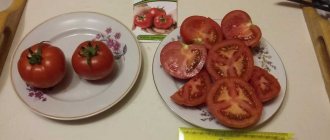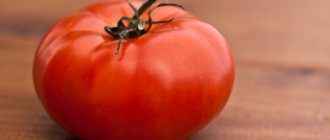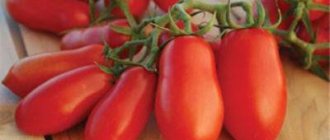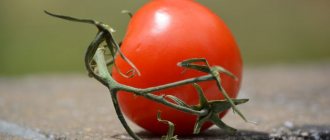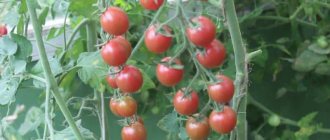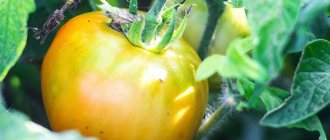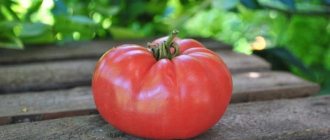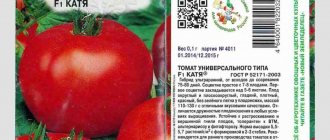Summer residents and gardeners, planting tomato seeds or seedlings in the beds of their plots, dream of getting early produce with good taste and resistance to a variety of vegetable diseases. With the arrival of spring, the gardening season begins, and those who like to grow their own tomato crops go shopping for seeds.
The most popular tomato seeds are for open ground. Moreover, not many gardeners like tall varieties, which must be tied to large supports and stepsoned. Basically, in the plots they try to grow low-growing tomato bushes, which require minimal care. The timing of ripening is also important for gardeners. The thing is that early-ripening varieties of tomatoes, which have a genetically accelerated rate of development, produce their harvest before the spread of tomato diseases. New products that may be of interest to gardeners include an ultra-early hybrid - Captain F1.
Tomato Captain: characteristics and description of the variety
Ultra early hybrid
The Captain tomato variety, bred for central Russia, the Urals and Siberia, is not inferior in taste to southern varieties. Captain refers to high-quality vegetable products included in the State Register of the Russian Federation.
This is a determinate plant. This means that tomato bushes are formed in a special way: when an inflorescence is formed at the top of the main stem, the plant’s growth stops. The bush grows approximately up to 70 cm. Stepchildren also stop growing when 2-4 flower clusters form on them. This variety has proven itself well when grown in open ground and in unheated greenhouses.
Early ripening variety – Captain F1
Fruits of a hybrid variety
Tomato fruits are dense, round in shape with a smooth, evenly colored surface. There is no white core on the cut, there are few seeds in the seed pockets, and it has a uniform fleshy surface. There is a small depression near the stalk. On average, the weight of a tomato is 100-120 grams. This ultra-early variety of tomatoes has an excellent taste, characteristic of ground tomatoes. The variety, bred as a salad variety, has proven itself well in winter canning. Captain tomatoes, which have dense pulp, produce thick pastes, juices, purees and ketchups.
Maturation
Captain tomatoes produce a harvest already on the 80th day from the moment of planting in open ground. The average yield of the variety depends on the place of growth. Tomatoes in open ground ripen by mid-July. The collection per square meter of area is no more than 10 kg. In the greenhouse, the harvest ripens a couple of decades earlier, that is, by the end of June, the harvest per square meter is approximately 17 kg.
Diseases
Characteristics of the Captain variety include invulnerability to fungal diseases and resistance to many tomato diseases, such as bacteriosis, late blight and tobacco mosaic virus (TMV).
Late blight
How are tomatoes different?
Early and ultra-early tomatoes have hard skin, dense flesh, and a sour taste. They are poured in cool weather. And I really want a real juicy berry!
Gardeners are happy to receive an early salad tomato. The captain gives just such fruits.
Characteristics of tomato:
- medium size: weight up to 130 g;
- ripe fruits of bright red color;
- absence of spots on the stalk;
- regular, spherical shape;
- a small depression at the stalk;
- the skin is dense;
- the pulp is juicy (dry matter – 7%);
- taste sweet and sour (sugar 3%);
- The aroma is bright, “tomato”.
Captain F1 delivers richly flavored fruits. Agronomists have developed a hybrid for salad purposes. But gardeners appreciated the sweetness of juices, ketchups, and lecho. The thick skin protects the pulp from leaking out during whole-fruit canning.
Agricultural technology
Soil type and planting location
Determinate variety of tomatoes - what is it?
Tomato seeds are planted in 10x10 cm containers in early March. The soil in the container should be heated to 25°C. Planting seeds earlier is not recommended to avoid getting elongated and frail shoots. It should be noted that Captain is a hybrid variety. Its seeds have undergone pre-sowing preparation, so they do not need to be soaked.
The depth of sowing seeds is no more than 0.5 cm. Containers with seeds are covered with glass or transparent film. Shoots appear on the fifth day from the moment of sowing. The film or glass is removed, and the containers with seedlings are placed in a bright place. The best option is a window sill. Further air temperature in the first week should be maintained up to 12°C, after which the temperature should be up to 18°C.
If you comply with all agrotechnical requirements: additional lighting, moderate watering and loosening the soil in the container, by the first days of May the seedlings will be ready for planting in a permanent place. Captain is suitable for breeding in open ground and in greenhouse conditions.
Planting tomatoes in open ground
Growing in a greenhouse
You can plant seedlings in a greenhouse a couple of weeks earlier than in the ground. Depending on whether the bush will be tied to a support or not, different planting schemes are chosen. When gartering, 4 to 8 plants are planted per 1 square meter. If you do not garter the bush, then 4-5 plants are planted. The second scheme makes it possible for untied stems that have sunk to the ground to give additional roots to the plant. They are sprinkled with earth, the rooted plant quickly increases the mass of fruits, and they ripen.
Attention! Air exchange must be ensured in the greenhouse; no matter how cool it is outside the greenhouse, the doors to it must be open. Tomatoes of this variety are not afraid of drafts.
Growing in soil
Seedlings are planted in the ground after returning spring frosts. This variety loves sandy and light loamy soil. It is recommended to plant in open ground according to the same schemes as in the greenhouse. It is worth paying attention to the fact that the Captain does not like the heat. It is necessary to shade bushes with tomatoes on hot days, otherwise at temperatures above 30°C the flowers will be sterilized and, as a result, ovaries will not form.
Advice. Gardeners recommend planting seedlings in a plot of the garden where cucumbers, cauliflower, parsley, carrots, zucchini and dill previously grew.
Care instructions
Top dressing
After planting the tomatoes in a permanent place, a week later the first fertilizing with mineral fertilizers is carried out. Mulching the soil or compost will do. The plant needs microelements for its growth and development: potassium, phosphorus, nitrogen. Feeding is repeated every 2-3 weeks until the end of fruiting.
Regardless of where tomatoes grow, at the moment when the ovary is formed and the fruits ripen, tomatoes require superphosphate and potassium sulfate. This fertilizer is scattered on the path and filled with water. Yes, it's chemistry. But sometimes manure cannot replace microelements, and the same potassium sulfate is also not present in manure. This measure is necessary for the plant, so one-time feeding with these fertilizers is performed.
During the growing season, plenty of sunlight and heat should be provided. With a sharp drop in temperature, the growth and ripening of tomatoes slows down, and fruiting decreases.
Need warmth and light
Weeding and loosening the soil
In beds with tomatoes, it is necessary to weed and loosen the soil once a week. The roots of tomatoes are shallow, so loosening must be done carefully so as not to damage them. If we are talking about beds in a greenhouse, and they are mulched, there is no need to loosen them.
Features of watering
For tomatoes to grow and ripen quickly, regular watering with warm water is required. In a greenhouse, watering is carried out between the rows in the usual way: using hoses or drip method, in “water communications” under the mulch.
If this is direct watering, the stream of water should not erode the soil around the tomato bush and expose the roots, as well as get on the leaves and fruits. Watering is carried out in the morning with heated water. Water temperature – not lower than 25°C.
Attention! If tomatoes grow in a greenhouse, the optimal humidity in it should be no more than 60%. When humidity is higher than this indicator, pollination of flowers deteriorates, they fall off, and the plant stretches. Even with high resistance to disease, such an environment causes damage to plants by fungal diseases.
The best early-ripening and high-yielding tomato varieties for open ground
Reading time: 11 minutes
The reason for the high popularity of early varieties of tomatoes for open ground is the rapid production of fruits without the need to create special greenhouse conditions for them. For areas of risky farming, early ripeness is the most important advantage, and in the south, two harvests of vegetables can be obtained from beds planted with early varieties.
Characteristics of early and ultra-early varieties
The main characteristic of early varieties is the ability to harvest 90-100 days after the sprouts emerge on the soil surface. Ultra-early hybrids will allow you to enjoy tomatoes already on the 70-85th day.
Early types of tomatoes are:
- determinate, the main stem of which stops growing after the first 4-6 clusters have set. They spend less effort on gathering green mass, using it to set and ripen fruits;
- indeterminate, continuing growth throughout the entire growing season. Caring for them is not complete without tying and pinching. Their advantage is that they eat a lot of fruit from the bush. They are cultivated without shelter only in the southern regions of the country.
Other characteristics of these varieties:
- Most of them have a thin skin, and the taste gives off a noticeable sweetness. Commonly used in salads or to make canned juice;
- with good agricultural technology, harvesting is 5-15 kg per 1 sq. meters of plantings;
- an important advantage is low incidence (ripening has time to occur before outbreaks of diseases common to the culture);
- Most super-early varieties have small fruits - 50-200 g.
Seed selection criteria
To properly navigate the sea of offers from seed product sellers, you should consider the following factors when purchasing:
- Landing region. All varieties that are included in the State Register of the country are oriented for cultivation in certain regions, that is, they are best adapted to their climate.
- Cultivation method (in open beds or in greenhouse conditions). For open ground, more hardy seeds are needed - they must withstand temperature changes and a wider range of weather conditions;
- The determinacy and indetermination of varieties affects how much effort must be put into growing them. Tall species are more productive, but require more attention and time.
- It is important to take into account when choosing the characteristics of the future harvest - taste, appearance, ability to tolerate transportation and shelf life. These qualities influence the possible uses and shelf life of vegetables.
- Hybrid or non-hybrid variety. F1 hybrids are more viable, more productive, and suffer less disease. However, every year you need to buy a new supply of seeds, since you cannot collect them from the fruit yourself.
An important characteristic for purchased seeds is packaging that preserves the properties of the seed. Only responsible manufacturers who are responsible for the quality of the products offered can offer this.
The best varieties of early ripening tomatoes
Careful selection of varieties based on the above criteria will ensure a decent harvest and will help plan work with seedlings and adult plants in advance.
The variety, distinguished by its yellow color, is determinant, unpretentious, and does not suffer from temperature changes. It takes about 100 days from germination to harvest. The height of the bushes is from half a meter to a meter, compact. The average weight of round fruits is 230-260 g. They are processed and consumed fresh.
Valentina
The variety is determinate, early ripening, productive. From the sprouts pipping to the first ripe fruits – 92-97 days. The height of the bushes is 0.6-0.75 m. Requires tying to a support or growing on a trellis. Needs partial stepsoning.
The variety is resistant to lack of moisture. The fruits do not crack. The crop ripens in one pore.
F1 President
Dutch indeterminate hybrid of exceptional productivity. It is cultivated without shelter only in the southern regions of the country. Tall, needs a garter to a support and regular removal of stepsons.
The fruits are round, dense, red in color, universally used and good taste. Productivity – up to 8 kg per bush.
Labrador
Labrador tomatoes can be harvested 95 days after germination. Determinate, unpretentious, productive variety. The bushes are standard, compact, strong. No need for stepsoning. Harvesting - up to 2.5 kg of fruit per plant.
The variety is resistant to weather changes and sets fruit well under unfavorable weather conditions. Is immune to major tomato diseases.
Marisha
Fruits in 80-90 days after full germination. Adapted to extreme conditions and sudden temperature changes. The bushes are low - up to half a meter, and do not need supports.
The fruits are round, medium-sized, 50-100 g on average. Universal purposes. Consumers note their pleasant taste.
The most popular ultra-early tomatoes for open ground
For northern zones of risky farming, ultra-early tomatoes with a ripening period of 75-90 days are the best option. Even a short summer is enough for them to ripen on the bushes later. Information about new varieties will help determine which of them are especially resistant to possible return frosts and temperature changes.
Maksimka
The development of domestic breeders is a determinate, semi-spreading variety with medium branching. Low-growing, no higher than 60 cm in height, the plants provide a yield of about 4.5 kg per square meter. They do not require pinching or gartering. The variety has complex resistance to many nightshade diseases. Withstands long-term transportation and long-term storage.
Far North
Standard low grade with a strong trunk. It grows no higher than 60 cm in height, so it does not need support.
The fruits are red, round, slightly elongated, and some are slightly ribbed. Average weight is 30-100 g. The taste is ordinary tomato, with a slight sourness. They are easy to transport and completely versatile in use.
Explosion
This hybrid was bred by domestic breeders already in our century, but managed to gain popularity due to its resistance to most “tomato” diseases and changes in weather conditions.
Benito
A very successful Dutch cluster hybrid of the first generation - high-yielding (depending on the growing zone - up to 8 kg of tomatoes per bush), determinate, and does not require pinching. An important point: the plants develop well and bear fruit even in shaded planting areas.
Golden stream
External attractiveness is far from the most important characteristic of a variety, although the golden-colored oval fruits certainly attract and delight the eye. Tomatoes weighing up to 80 g, with pronounced sweetness. Convenient to preserve, tasty fresh.
Advantages and disadvantages of the variety
Parthenocarpic variety of cucumbers: what is it?
To talk on this topic, you need to understand what kind of variety is this, marked with the letter F? Hybrid F1 is a combination of positive properties of one species, but its seeds are obtained after crossing two, three or more varietal forms. To obtain a hybrid plant with the desired varietal qualities, parent plants with the required genes are selected. The resulting hybrid is more productive than its parent varieties. The hybrid is immune to persistent tomato diseases. These are the main advantages.
Attention! A hybrid plant is unable to retain all its positive qualities when re-sown from the seeds of the resulting crop. That is, the advantages and all the positive qualities of Captain F1 are preserved only in the first generation, with a single sowing. In the future, when using seeds of a hybrid variety, the positive qualities decrease. This can be attributed to the shortcomings, and not only of this hybrid.
Secrets of growing tomatoes and getting a rich harvest of fruits
Every experienced gardener has his own secrets that guarantee high yields even in unfavorable weather conditions. The following tips stand out as effective and interesting.
- To increase the yield during the flowering period of the second and third clusters, it is recommended to spray the plant with a solution based on boric acid (weak concentration). Boron promotes pollen germination, ovary formation and fruiting.
- Most tomatoes are self-pollinating. But under unfavorable conditions, the pollination process is poorly carried out, so the plant could use human help. To do this, you need to lightly shake the bush once every 3-6 days .
- Mulching beds with tomatoes prevents the soil from drying out and the formation of crust on the soil surface. In addition, mulch reduces the growth rate of weeds, the main enemy of vegetable crops.
- Autumn soil preparation ensures an increase in yield if compost and manure in combination with peat are used as fertilizers.
- For many gardeners, pinching remains an unexplored activity, so not everyone succeeds in getting fruits with the characteristics described on the seed label. Removing useless shoots redirects the flow of nutrition and energy to produce larger tomatoes. In addition, they have time to ripen before the end of the season.
From the experience of gardeners
Zucchini variety
Some gardeners are accustomed to growing seedlings from tomato seeds obtained on their plots; a variety such as Captain F1 will not suit them, breeders believe. Seeds of this variety need to be purchased. Only seeds from bags guarantee that this hybrid variety will produce exactly the harvest that gardeners expect.
However, there are quite a lot of reviews about the positive experience of using seeds collected from a hybrid plant. If gardeners like to experiment, then it’s worth trying to grow tomatoes from hybrid seeds.
Captain F1 should not be confused with a new selection called Captain Lucky tomato. This is an indeterminate (tall) tomato with medium-late fruits. Super-exotic has elegant green-yellow-pink fruits.
So, to get a good harvest of Captain variety tomatoes, you should follow simple rules for planting and caring for plants:
- Prepare the soil for planting and, according to agrotechnical requirements, grow seedlings;
- Carry out fertilizing and loosening;
- Monitor the temperature and humidity in the greenhouse;
- Perform regular watering.
By fulfilling all these requirements, gardeners and summer residents will receive a good harvest on their land.
What kind of soil do tomatoes like?
Tomatoes can grow on almost any soil; the question is the amount of preparatory work.
The best cultivation results are observed on nutritious, loose soils with good moisture and breathability. Loams, for example, have these qualities. The medium should be neutral or slightly acidic, but not acidic.
Before planting, you need to check the pH level using laboratory tests or litmus paper. If the indicator exceeds 5.5-6.5, then treatment should be carried out to adjust the acidity. To do this, dolomite flour or crushed lime is sprayed onto the soil surface, which is then carefully mixed with the soil using a rake.
Soil acidity before planting is controlled by liming
The soil for tomatoes should be fertile, enriched with potassium, nitrogen, phosphorus, iron, zinc and other microelements.
When applying fertilizers at the stage of preparing a site for planting seedlings, both organic fertilizers and complex mineral fertilizers are used. However, it is worth considering that you should not get carried away with nutrient mixtures; you can burn out young shoots or provoke intensive growth of greenery to the detriment of fruit formation.
Tomato Hybrid Tarasenko
This is where the confusion begins. The fact is that tomatoes under this name are not hybrids at all, but varieties! Moreover, they are quite interesting and popular, such as Hybrid Tarasenko, Yubileiny, Tomato Tarasenko. They were brought out by an amateur vegetable grower from the Sumy region, Feodosiy Tarasenko, a physics teacher who was fond of gardening. His track record includes about 50 varieties of tomatoes.
How to avoid confusion and choose the right hybrid specifically for your conditions, read our convincing guide to choosing tomato varieties and hybrids.
You can learn more about how F1 hybrids are made from our article >>>>>>
Read all about growing tomatoes (tomatoes) in our selection of materials here >>>>>>>>>>
